最新英语诗歌韵脚
- 格式:doc
- 大小:27.00 KB
- 文档页数:10
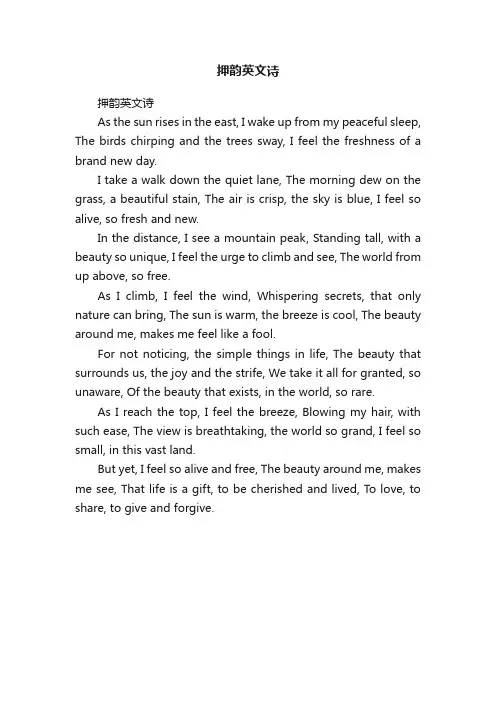
押韵英文诗押韵英文诗As the sun rises in the east, I wake up from my peaceful sleep, The birds chirping and the trees sway, I feel the freshness of a brand new day.I take a walk down the quiet lane, The morning dew on the grass, a beautiful stain, The air is crisp, the sky is blue, I feel so alive, so fresh and new.In the distance, I see a mountain peak, Standing tall, with a beauty so unique, I feel the urge to climb and see, The world from up above, so free.As I climb, I feel the wind, Whispering secrets, that only nature can bring, The sun is warm, the breeze is cool, The beauty around me, makes me feel like a fool.For not noticing, the simple things in life, The beauty that surrounds us, the joy and the strife, We take it all for granted, so unaware, Of the beauty that exists, in the world, so rare.As I reach the top, I feel the breeze, Blowing my hair, with such ease, The view is breathtaking, the world so grand, I feel so small, in this vast land.But yet, I feel so alive and free, The beauty around me, makes me see, That life is a gift, to be cherished and lived, T o love, to share, to give and forgive.。
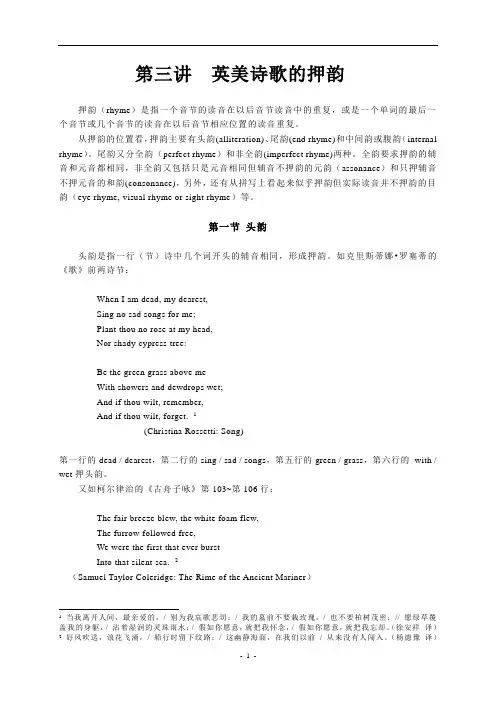
第三讲英美诗歌的押韵押韵(rhyme)是指一个音节的读音在以后音节读音中的重复,或是一个单词的最后一个音节或几个音节的读音在以后音节相应位置的读音重复。
从押韵的位置看,押韵主要有头韵(alliteration)、尾韵(end rhyme)和中间韵或腹韵(internal rhyme)。
尾韵又分全韵(perfect rhyme)和非全韵(imperfect rhyme)两种。
全韵要求押韵的辅音和元音都相同,非全韵又包括只是元音相同但辅音不押韵的元韵(assonance)和只押辅音不押元音的和韵(consonance),另外,还有从拼写上看起来似乎押韵但实际读音并不押韵的目韵(eye rhyme, visual rhyme or sight rhyme)等。
第一节头韵头韵是指一行(节)诗中几个词开头的辅音相同,形成押韵。
如克里斯蒂娜•罗塞蒂的《歌》前两诗节:When I am dead, my dearest,Sing no sad songs for me;Plant thou no rose at my head,Nor shady cypress tree:Be the green grass above meWith showers and dewdrops wet;And if thou wilt, remember,And if thou wilt, forget. 1(Christina Rossetti: Song)第一行的dead / dearest,第二行的sing / sad / songs,第五行的green / grass,第六行的with / wet押头韵。
又如柯尔律治的《古舟子咏》第103~第106行:The fair breeze blew, the white foam flew,The furrow followed free,We were the first that ever burstInto that silent sea. 2(Samuel Taylor Coleridge: The Rime of the Ancient Mariner)1当我离开人间,最亲爱的,/ 别为我哀歌悲切;/ 我的墓前不要栽玫瑰,/ 也不要柏树茂密;// 愿绿草覆盖我的身躯,/ 沾着湿润的灵珠雨水;/ 假如你愿意,就把我怀念,/ 假如你愿意,就把我忘却。
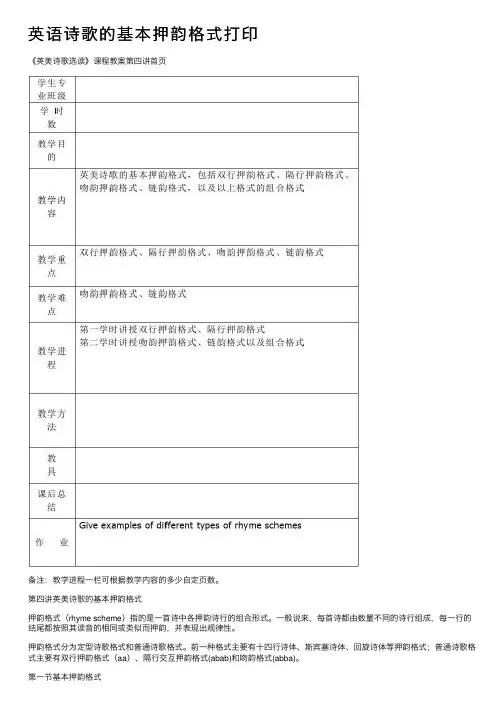
英语诗歌的基本押韵格式打印《英美诗歌选读》课程教案第四讲⾸页备注:教学进程⼀栏可根据教学内容的多少⾃定页数。
第四讲英美诗歌的基本押韵格式押韵格式(rhyme scheme)指的是⼀⾸诗中各押韵诗⾏的组合形式。
⼀般说来,每⾸诗都由数量不同的诗⾏组成,每⼀⾏的结尾都按照其读⾳的相同或类似⽽押韵,并表现出规律性。
押韵格式分为定型诗歌格式和普通诗歌格式。
前⼀种格式主要有⼗四⾏诗体、斯宾塞诗体、回旋诗体等押韵格式;普通诗歌格式主要有双⾏押韵格式(aa)、隔⾏交互押韵格式(abab)和吻韵格式(abba)。
第⼀节基本押韵格式⼀、双⾏押韵格式(aa)它是英语诗歌最基本押韵格式,主要⽤于双⾏诗节(couplet)。
双⾏诗节指两⾏押韵或不押韵的诗⾏。
双⾏诗节可以单独成为诗节,也可以存在于其他诗节中。
七⾏体(⼜称皇韵体,rhyme royal)诗和⼋⾏体(octa rima)诗⽤双⾏诗节结束,莎⼠⽐亚的⼗四⾏诗也是⽤双⾏诗节结束全诗。
双⾏诗节分开放双⾏诗节(open couplet)和完整双⾏诗节(closed couplet)两种。
完整双⾏诗节如果是⽤抑扬格五韵步写成,就被称为英雄双⾏诗节(heroic couplet)。
开放双⾏诗节指的是跨⾏的双⾏诗体,即两⾏诗有共同的语法和逻辑结构,但第⼆⾏的意思需要继续下去,直到在后⾯的诗⾏中结束。
如济慈叙述希腊神话中的美少年长诗《恩弟⽶安》开始⼏⾏:A thing of beauty is a joy for ever:Its loveliness increases; it will neverPass into nothingness; but still will keepA bower quiet for us, and a sleepFull of sweet dreams, and health, and quiet breathing.Therefore, on every morrow, are we wreathingA flowery band to bind us to the earth,Spite of despondence, of the inhuman dearthOf noble natures (1)(John Keats: Endymion)这些诗⾏的特点是:⾸先,每两⾏押韵,即ever / never,keep / sleep,breathing / wreathing,earth / dearth押韵。
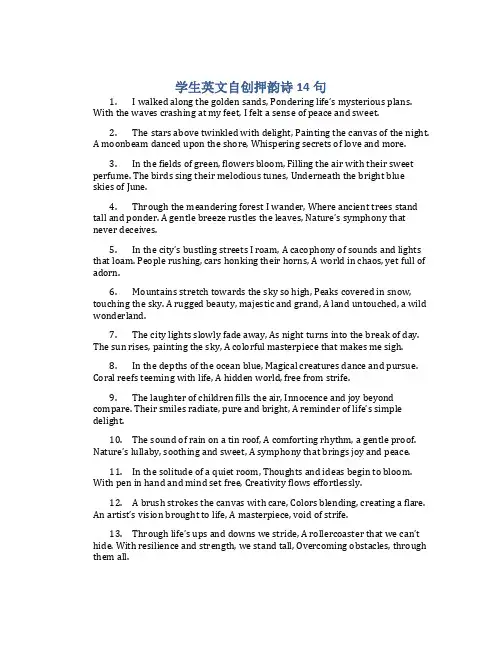
学生英文自创押韵诗14句1.I walked along the golden sands, Pondering life’s mysterious plans. With the waves crashing at my feet, I felt a sense of peace and sweet.2.The stars above twinkled with delight, Painting the canvas of the night.A moonbeam danced upon the shore, Whispering secrets of love and more.3.In the fields of green, flowers bloom, Filling the air with their sweet perfume. The birds sing their melodious tunes, Underneath the bright blue skies of June.4.Through the meandering forest I wander, Where ancient trees stand tall and ponder. A gentle breeze rustles the leaves, Nature’s symphony that never deceives.5.In the city’s bustling streets I roam, A cacophony of sounds and lights that loam. People rushing, cars honking their horns, A world in chaos, yet full of adorn.6.Mountains stretch towards the sky so high, Peaks covered in snow, touching the sky. A rugged beauty, majestic and grand, A land untouched, a wild wonderland.7.The city lights slowly fade away, As night turns into the break of day. The sun rises, painting the sky, A colorful masterpiece that makes me sigh.8.In the depths of the ocean blue, Magical creatures dance and pursue. Coral reefs teeming with life, A hidden world, free from strife.9.The laughter of children fills the air, Innocence and joy beyond compare. Their smiles radiate, pure and bright, A reminder of life’s simple delight.10.The sound of rain on a tin roof, A comforting rhythm, a gentle proof. Nature’s lullaby, soothing and sweet, A symphony that brings joy and peace.11.In the solitude of a quiet room, Thoughts and ideas begin to bloom. With pen in hand and mind set free, Creativity flows effortlessly.12. A brush strokes the canvas with care, Colors blending, creating a flare. An artist’s vision brought to life, A ma sterpiece, void of strife.13.Through life’s ups and downs we stride, A rollercoaster that we can’t hide. With resilience and strength, we stand tall, Overcoming obstacles, through them all.14.As the day comes to an end, The sky ablaze with colors that transcend.A sunset’s beauty, a final farewell, A reminder that in this world we dwell.These 14 lines of rhyming poetry explore various aspects of nature, human emotions, and the beauty of the world around us. Each line captures a fleeting moment or a profound experience, offering a glimpse into the vastness and complexity of life.。
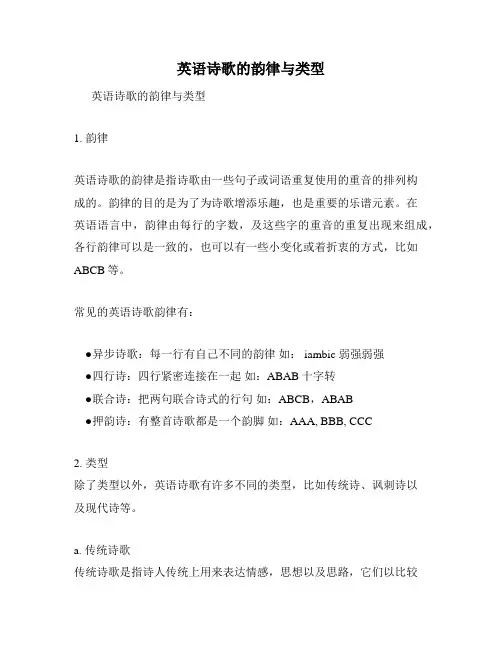
英语诗歌的韵律与类型
英语诗歌的韵律与类型
1. 韵律
英语诗歌的韵律是指诗歌由一些句子或词语重复使用的重音的排列构
成的。
韵律的目的是为了为诗歌增添乐趣,也是重要的乐谱元素。
在
英语语言中,韵律由每行的字数,及这些字的重音的重复出现来组成,各行韵律可以是一致的,也可以有一些小变化或着折衷的方式,比如ABCB等。
常见的英语诗歌韵律有:
●异步诗歌:每一行有自己不同的韵律如: iambic 弱强弱强
●四行诗:四行紧密连接在一起如:ABAB十字转
●联合诗:把两句联合诗式的行句如:ABCB,ABAB
●押韵诗:有整首诗歌都是一个韵脚如:AAA, BBB, CCC
2. 类型
除了类型以外,英语诗歌有许多不同的类型,比如传统诗、讽刺诗以
及现代诗等。
a. 传统诗歌
传统诗歌是指诗人传统上用来表达情感,思想以及思路,它们以比较
高度的艺术性组合构成,较为规范。
传统诗歌有很多不同的流派,比如锐诗、吟诗、抒情诗等。
b. 讽刺诗
讽刺诗是指诗人在创作的时候,用一定的文体来进行批判的诗篇。
一般来讲,讽刺诗会拿一下子生活中常见的现象或事件进行批判,来表达对社会出现什么冲突或问题以及社会不公正现象的情绪或感受。
c. 现代诗
现代诗歌是英语诗歌的一种发展趋势,这种类型的诗歌会跳脱传统的规则,形式上比较自由,有更多的表现形式。
现代诗的内容也更加广泛,如果说传统诗歌更倾向于文学表达,那么现代诗歌对实际的日常生活的描述,要求创作者运用多种技巧,来表现真实的生活问题。
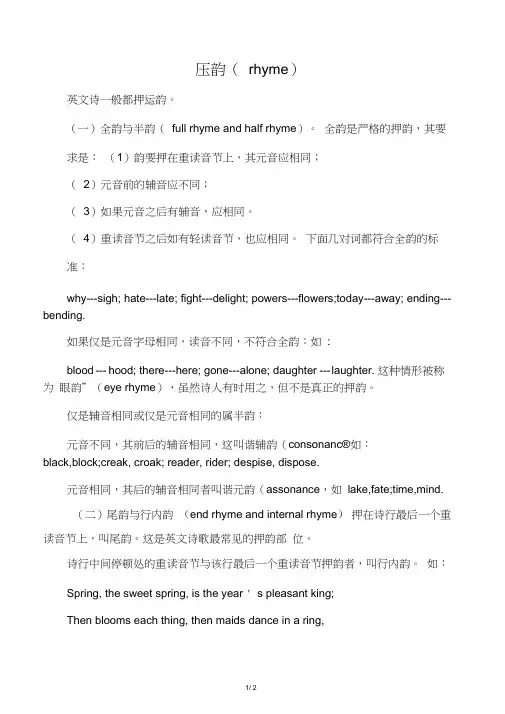
压韵(rhyme)英文诗一般都押运韵。
(一)全韵与半韵(full rhyme and half rhyme)。
全韵是严格的押韵,其要求是:(1)韵要押在重读音节上,其元音应相同;(2)元音前的辅音应不同;(3)如果元音之后有辅音,应相同。
(4)重读音节之后如有轻读音节,也应相同。
下面几对词都符合全韵的标准:why---sigh; hate---late; fight---delight; powers---flowers;today---away; ending--- bending.如果仅是元音字母相同,读音不同,不符合全韵:如:blood --- hood; there---here; gone---alone; daughter --- l aughter. 这种情形被称为眼韵”(eye rhyme),虽然诗人有时用之,但不是真正的押韵。
仅是辅音相同或仅是元音相同的属半韵:元音不同,其前后的辅音相同,这叫谐辅韵(consonanc®如:black,block;creak, croak; reader, rider; despise, dispose.元音相同,其后的辅音相同者叫谐元韵(assonance,如lake,fate;time,mind.(二)尾韵与行内韵(end rhyme and internal rhyme)押在诗行最后一个重读音节上,叫尾韵。
这是英文诗歌最常见的押韵部位。
诗行中间停顿处的重读音节与该行最后一个重读音节押韵者,叫行内韵。
如:Spring, the sweet spring, is the year ' s pleasant king;Then blooms each thing, then maids dance in a ring,(三)男韵与女韵((masculine rhyme and feminine rhyme)所押的韵音局限于诗行中重读的末尾音节上,称男韵,也叫单韵,听起来强劲有力。
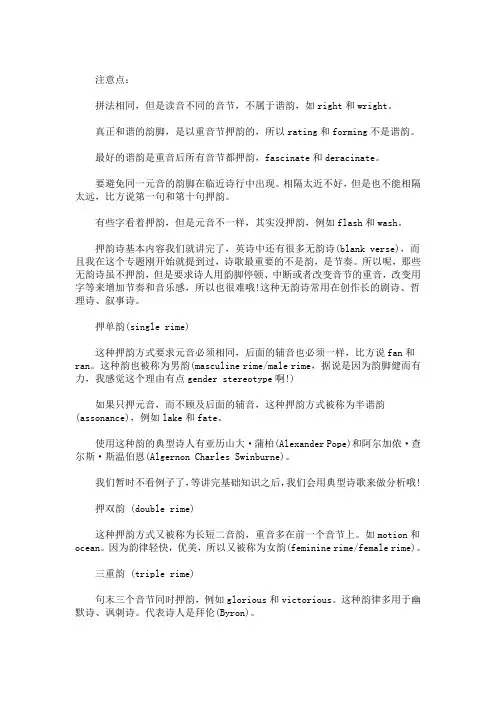
注意点:拼法相同,但是读音不同的音节,不属于谐韵,如right和wright。
真正和谐的韵脚,是以重音节押韵的,所以rating和forming不是谐韵。
最好的谐韵是重音后所有音节都押韵,fascinate和deracinate。
要避免同一元音的韵脚在临近诗行中出现。
相隔太近不好,但是也不能相隔太远,比方说第一句和第十句押韵。
有些字看着押韵,但是元音不一样,其实没押韵,例如flash和wash。
押韵诗基本内容我们就讲完了,英诗中还有很多无韵诗(blank verse),而且我在这个专题刚开始就提到过,诗歌最重要的不是韵,是节奏。
所以呢,那些无韵诗虽不押韵,但是要求诗人用韵脚停顿、中断或者改变音节的重音,改变用字等来增加节奏和音乐感,所以也很难哦!这种无韵诗常用在创作长的剧诗、哲理诗、叙事诗。
押单韵(single rime)这种押韵方式要求元音必须相同,后面的辅音也必须一样,比方说fan和ran。
这种韵也被称为男韵(masculine rime/male rime,据说是因为韵脚健而有力,我感觉这个理由有点gender stereotype啊!)如果只押元音,而不顾及后面的辅音,这种押韵方式被称为半谐韵(assonance),例如lake和fate。
使用这种韵的典型诗人有亚历山大·蒲柏(Alexander Pope)和阿尔加侬·查尔斯·斯温伯恩(Algernon Charles Swinburne)。
我们暂时不看例子了,等讲完基础知识之后,我们会用典型诗歌来做分析哦!押双韵 (double rime)这种押韵方式又被称为长短二音韵,重音多在前一个音节上。
如motion和ocean。
因为韵律轻快,优美,所以又被称为女韵(feminine rime/female rime)。
三重韵 (triple rime)句末三个音节同时押韵,例如glorious和victorious。
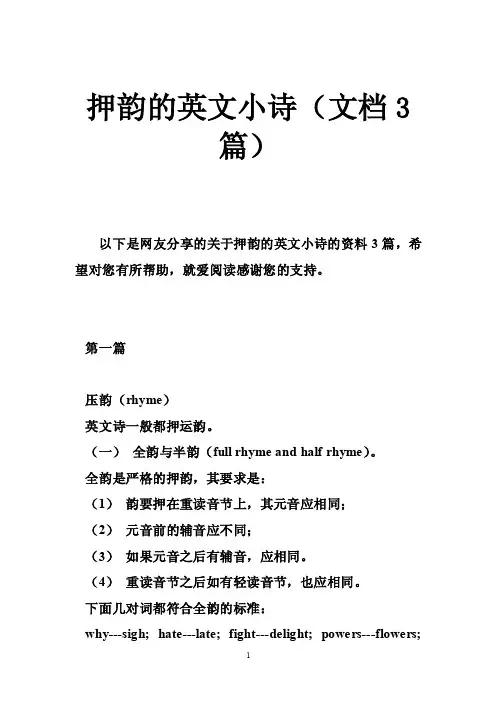
押韵的英文小诗(文档3篇)以下是网友分享的关于押韵的英文小诗的资料3篇,希望对您有所帮助,就爱阅读感谢您的支持。
第一篇压韵(rhyme)英文诗一般都押运韵。
(一)全韵与半韵(full rhyme and half rhyme)。
全韵是严格的押韵,其要求是:(1)韵要押在重读音节上,其元音应相同;(2)元音前的辅音应不同;(3)如果元音之后有辅音,应相同。
(4)重读音节之后如有轻读音节,也应相同。
下面几对词都符合全韵的标准:why---sigh; hate---late; fight---delight; powers---flowers;today---away; ending---bending.如果仅是元音字母相同,读音不同,不符合全韵:如: blood----hood; there---here; gone---alone; daughter----laughter. 这种情形被称为―眼韵‖(eye rhyme),虽然诗人有时用之,但不是真正的押韵。
仅是辅音相同或仅是元音相同的属半韵:元音不同,其前后的辅音相同,这叫谐辅韵(consonance)如:black, block; creak, croak; reader, rider; despise, dispose. 元音相同,其后的辅音相同者叫谐元韵(assonance),如lake, fate; time, mind.(二)尾韵与行内韵(end rhyme and internal rhyme)押在诗行最后一个重读音节上,叫尾韵。
这是英文诗歌最常见的押韵部位。
诗行中间停顿处的重读音节与该行最后一个重读音节押韵者,叫行内韵。
如:Spring, the sweet spring, is the year’s pleasant king;Then blooms each thing, then maids dance in a ring,(三)男韵与女韵((masculine rhyme and feminine rhyme) 所押的韵音局限于诗行中重读的末尾音节上,称男韵,也叫单韵,听起来强劲有力。
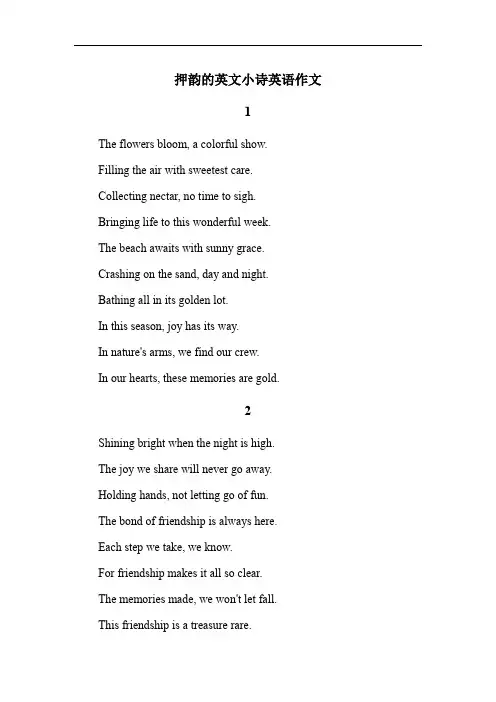
押韵的英文小诗英语作文1The flowers bloom, a colorful show.Filling the air with sweetest care.Collecting nectar, no time to sigh.Bringing life to this wonderful week.The beach awaits with sunny grace. Crashing on the sand, day and night.Bathing all in its golden lot.In this season, joy has its way.In nature's arms, we find our crew.In our hearts, these memories are gold.2Shining bright when the night is high.The joy we share will never go away. Holding hands, not letting go of fun.The bond of friendship is always here.Each step we take, we know.For friendship makes it all so clear.The memories made, we won't let fall.This friendship is a treasure rare.3 The world awakes in hues so true. Nature's dance, a joyous room. Thunder roars, rain pours at night. Under the sun, hearts take their toll. Like dancers in a silent dance.The wind blows, a peaceful sign. Blanketing the world in silent might.A wonderland, beyond all ill.Each holds beauty, a tale to shine.A symphony, nature's gentle flow.4 Dreams Shine BrightDreams like stars give hope and light. Filling our hearts with endless ray. But with courage, we'll not complain. We'll keep striving, not say goodbye. We'll stand firm, not shed a tear. Burning bright, our spirits inspire.In the power of our dreaming.To the land where dreams flower.But our dreams, they are our guard.And reach the stars, shining so bright.5The meaning of life, a mystery profound and meek. To find the true self, alive and alive.Full of choices, sometimes confusing.Guiding me towards a purpose, not just falling. Discovering treasures of wisdom and prime. Shining bright, beyond any hem.Exploring the unknown, with hope as the quest. For within, lies the truth, come what may.。
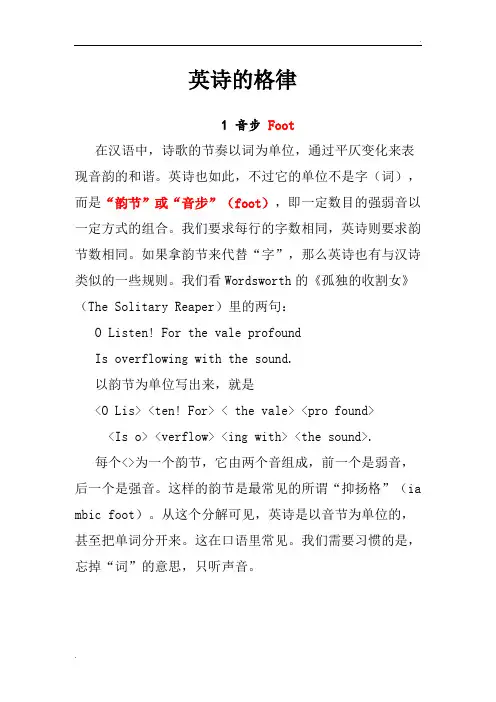
英诗的格律1 音步Foot在汉语中,诗歌的节奏以词为单位,通过平仄变化来表现音韵的和谐。
英诗也如此,不过它的单位不是字(词),而是“韵节”或“音步”(foot),即一定数目的强弱音以一定方式的组合。
我们要求每行的字数相同,英诗则要求韵节数相同。
如果拿韵节来代替“字”,那么英诗也有与汉诗类似的一些规则。
我们看Wordsworth的《孤独的收割女》(The Solitary Reaper)里的两句:O Listen! For the vale profoundIs overflowing with the sound.以韵节为单位写出来,就是<O Lis> <ten! For> < the vale> <pro found><Is o> <verflow> <ing with> <the sound>.每个<>为一个韵节,它由两个音组成,前一个是弱音,后一个是强音。
这样的韵节是最常见的所谓“抑扬格”(ia mbic foot)。
从这个分解可见,英诗是以音节为单位的,甚至把单词分开来。
这在口语里常见。
我们需要习惯的是,忘掉“词”的意思,只听声音。
有了抑扬格的例子,就不难理解所有其他形式了,据说古代有20多种呢。
不过,现代英诗最通行的只有四种,除了抑扬格外,还有扬抑格(Trochaic foot)、抑抑扬格(A napaestic foot)、扬抑抑格(Dactylic foot):若干韵节构成一行诗句,它的长度叫meter。
最短的当然只有一个韵节(monometer),最长的有八个(octameter),而最流行的是五个,即所谓的“五音步”(pentameter),而且常常是抑扬格的,这就是iambic pentameter。
一音步(monometer)二音步(dimeter)三音步(trimeter)四音步(tetrameter)五音步(pentameter)六音步(hexameter)七音步(heptameter)八音步(octameter)借音步来说,我们的七律是四音步的,如“无边落木萧萧下”,“春蚕到死丝方尽”等。
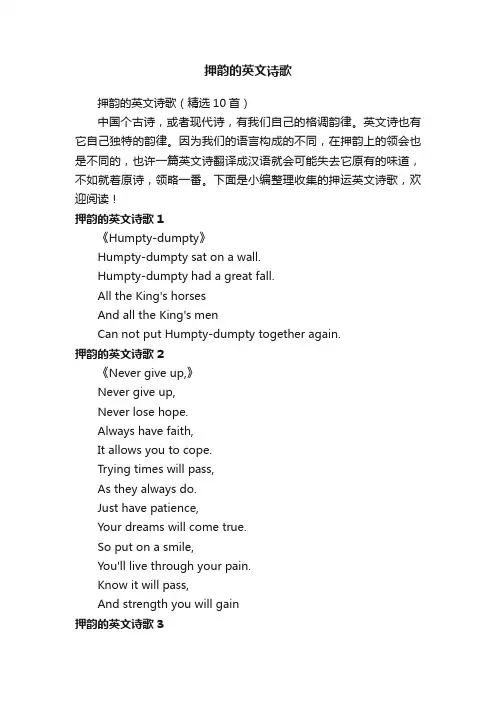
押韵的英文诗歌押韵的英文诗歌(精选10首)中国个古诗,或者现代诗,有我们自己的格调韵律。
英文诗也有它自己独特的韵律。
因为我们的语言构成的不同,在押韵上的领会也是不同的,也许一篇英文诗翻译成汉语就会可能失去它原有的味道,不如就着原诗,领略一番。
下面是小编整理收集的押运英文诗歌,欢迎阅读!押韵的英文诗歌1《Humpty-dumpty》Humpty-dumpty sat on a wall.Humpty-dumpty had a great fall.All the King's horsesAnd all the King's menCan not put Humpty-dumpty together again.押韵的英文诗歌2《Never give up,》Never give up,Never lose hope.Always have faith,It allows you to cope.Trying times will pass,As they always do.Just have patience,Your dreams will come true.So put on a smile,You'll live through your pain.Know it will pass,And strength you will gain押韵的英文诗歌3《Trying》I thought it boringDo nothing I wantTryingTrying and tryingI found it boringEndingI thought it interestingDo what I wantDoingDoing and doingI found it excitingContinuing押韵的英文诗歌4《keep positive》If you want to keep positiveIf you hate being negativeJust come down to my dreamAnd come down with a smileIt is my own worldI will show you the methodTo be happy and positiveAnd say goodbye to negativeThere has everythingHas all the happy thingYou just need to enjoyAnd leave with a smileAlthough you aren't hereWith no my dreams thereDon't forget to smileAnd never lose smile押韵的'英文诗歌5《by Thomas Heise》My birthright I have traded for a petal dressand a summer eulogy. I have pawned my soulfor this opal ring, the color of a pale, taxidermied eye.If I could carry calla lilies on my shoulder once morelike an umbrella in daylight, I would lean themon the cemetery gate and sleep until the groundskeeper found me.For some of us, beauty is carcinoma.The saint‘s stigmata is god’s rose, bestowedfor forgoing a human lover, who will, of course, die.I died last year. My mother made her tears into crystalearrings and clipped them to my ears.“Son, you willpay for your sin,“ my father spoke from his throne of glass.Stars burn a sharp, white nacre until they evaporate.The moon‘s flamingo unfolds her iodine wings over the broken city.My necropolis. My teeth are the fruit of your olive tree.押韵的英文诗歌6《EpistlefromMrs.Yonge to Her Husband》by Lady Mary Wortley MontaguThink not this paper comes with vain pretenseTo move your pity, or to mourn th' offense.Too well I know that hard obdurate heat;No softening mercy there will take my part,Nor can a woman's arguments prevail,When even your patron's wise example fails.But this last privilege I still retain;Th' oppressed and injured always may complain Too, too severely laws of honor bindThe weak submissive sex of womankind.If sighs have gained or force compelled our hand,Deceived by art, or urged by stern command,Whatever motive binds the fatal tie,The judging world expects our constancy.Just heaven!(for sure in heaven does justice reign,Though tricks below that sacred name profane)To you appealing I submit my cause,Nor fear a judgment from impartial laws.All bargains but conditional are made;The purchase void, the creditor unpaid;Defrauded servants are from service free;A wounded slave regains his liberty.For wives ill used no remedy remains,To daily racks condemned, and to eternal chains.From whence is this unjust distinction grown?Are we not formed with passions like your own? Nature with equal fire our souls endued,Our minds as haughty, and as warm as our blood;O'er the wide world your pleasures you pursue,The change is justified by something new;But we must sigh in silence——and be true.Our sex's weakness you expose and blame(Of every prattling fop the common theme),Yet from this weakness you suppose is due Sublimer virtue that your Cato knew.Had heaven designed us trials so severe,It would have formed our tempers then to bear.And I have borne (oh what have I not borne!)The pang of jealousy, the insults of scorn.Wearied at length, I from your sight remove,And place my future hopes in secret love.In the gay bloom of glowing youth retired,I quit the woman's joy to be admired,With that small pension your hard heart allows,Renounce your fortune, and release your vows.To custom (though unjust) so much is due;I hide my frailty from the public view.My conscience clear, yet sensible of shame,My life I hazard, to preserve my fame.And I prefer this low inglorious stateTo vile dependence on the thing I hate——But you pursue me to this last retreat.Dragged into light, my tender crime is shown And every circumstance of fondness known.Beneath the shelter of the law you stand,And urge my ruin with a cruel hand,While to my fault thus rigidly severe,Tamely submissive to the man you fear.This wretched outcast, this abandoned wife,Has yet this joy to sweeten shameful life:By your mean conduct, infamously loose,You are at once my accuser and excuse.Let me be damned by the censorious prude (Stupidly dull, or spiritually lewd),My hapless case will surely pity findFrom every just and reasonable mind.When to the final sentence I submit,The lips condemn me, but their souls acquit.No more my husband, to your pleasures go,The sweets of your recovered freedom know.Go: court the brittle friendship of the great,Smile at his board, or at his levee wait;And when dismissed, to madam's toilet fly,More than her chambermaids, or glasses, lie,Tell her how young she looks, how heavenly fair,Admire the lilies and the roses there.Your high ambition may be gratified,Some cousin of her own be made your bride,And you the father of a glorious raceEndowed with Ch——l's strength and Low——r's face.押韵的英文诗歌7《Father's Day》父亲节Mary Frances Bogle玛丽·弗朗西斯·博格Over the years多年来,As we grow old,随着我们逐渐长大,We remember our father总想起我们的父亲,So brave and bold.那样勇敢而无畏。
第一节头韵头韵是指一行(节)诗中几个词开头的辅音相同,形成押韵。
如克里斯蒂娜•罗塞蒂的《歌》前两诗节:When I am dead, my dearest,Sing no sad songs for me;Plant thou no rose at my head,Nor shady cypress tree:Be the green grass above meWith showers and dewdrops wet;And if thou wilt, remember,And if thou wilt, forget.(Christina Rossetti: Song)第一行的dead / dearest,第二行的sing / sad / songs,第五行的green / grass,第六行的with / wet押头韵。
又如柯尔律治的《古舟子咏》第103~第106行:The fair breeze blew, the white foam flew,The furrow followed free,We were the first that ever burstInto that silent sea.(Samuel Taylor Coleridge: The Rime of the Ancient Mariner)前三行里,头韵[f]重复七次。
这个摩擦送气的清辅音模仿柔风轻涛的声音,创造出一种宁静的意境。
第四行里的两个[s]音宛如和风吹过沉寂海面而发出的咝咝声。
头韵在这里的使用,令读者有身临其境之感。
另外,中间韵blew / flew,first / burst,furrow / followed,尾韵free / sea形成悦耳动听的韵味和节奏感。
再如莎士比亚编号为71的十四行诗前八行:No longer mourn for me when I am deadThan you shall hear the surly sullen bellGive warning to the world that I am fledFrom this vile world with vilest worms to dwell.Nay, if you read this line, remember notThe hand that writ it; for I love you soThat I in your sweet thoughts would be forgotIf thinking on me would make you woe.每行都有不同的头韵。
第三讲英美诗歌的押韵押韵(rhyme)是指一个音节的读音在以后音节读音中的重复,或是一个单词的最后一个音节或几个音节的读音在以后音节相应位置的读音重复。
从押韵的位置看,押韵主要有头韵(alliteration)、尾韵(end rhyme)和中间韵或腹韵(internal rhyme)。
尾韵又分全韵(perfect rhyme)和非全韵(imperfect rhyme)两种。
全韵要求押韵的辅音和元音都相同,非全韵又包括只是元音相同但辅音不押韵的元韵(assonance)和只押辅音不押元音的和韵(consonance),另外,还有从拼写上看起来似乎押韵但实际读音并不押韵的目韵(eye rhyme, visual rhyme or sight rhyme)等。
第一节头韵头韵是指一行(节)诗中几个词开头的辅音相同,形成押韵。
如克里斯蒂娜•罗塞蒂的《歌》前两诗节:When I am dead, my dearest,Sing no sad songs for me;Plant thou no rose at my head,Nor shady cypress tree:Be the green grass above meWith showers and dewdrops wet;And if thou wilt, remember,And if thou wilt, forget. 1(Christina Rossetti: Song)第一行的dead / dearest,第二行的sing / sad / songs,第五行的green / grass,第六行的with / wet押头韵。
又如柯尔律治的《古舟子咏》第103~第106行:The fair breeze blew, the white foam flew,The furrow followed free,We were the first that ever burstInto that silent sea. 2(Samuel Taylor Coleridge: The Rime of the Ancient Mariner)前三行里,头韵[f]重复七次。
优美英文诗歌好押韵(双语)(最新版)编制人:__________________审核人:__________________审批人:__________________编制单位:__________________编制时间:____年____月____日序言下载提示:该文档是本店铺精心编制而成的,希望大家下载后,能够帮助大家解决实际问题。
文档下载后可定制修改,请根据实际需要进行调整和使用,谢谢!并且,本店铺为大家提供各种类型的经典范文,如诗词歌赋、教学资料、作文大全、总结计划、党团报告、活动方案、制度手册、名言警句、祝福语、其他范文等等,想了解不同范文格式和写法,敬请关注!Download tips: This document is carefully compiled by this editor.I hope that after you download it, it can help you solve practical problems. The document can be customized and modified after downloading, please adjust and use it according to actual needs, thank you!In addition, this shop provides you with various types of classic sample essays, such as poems and songs, teaching materials, essays, summary plans, party reports, activity plans, system manuals, famous sayings, blessings, other sample essays, etc., I want to know Please pay attention to the different format and writing styles of sample essays!优美英文诗歌好押韵(双语)I strove with none, for none was worth my strife.我和谁都不争,和谁争我都不屑;Nature I loved, and next to Nature, Art.我爱大自然,其次就是艺术;下面就是本店铺给大家带来的英文诗歌,希望能帮助到大家!1The First Jasmine第一次手捧茉莉花Rabindranath Tagore罗宾德拉纳特•泰戈尔AH, these jasmines, these white jasmines!啊,这些茉莉花,这些白色的茉莉花!I seem to remember the first day when I filled my hands with these jasmines, these white jasmines.我仿佛记得当我第一次双手满捧着这些茉莉花,这洁白的茉莉花的时候。
押韵的英文诗歌导语:中国个古诗,或者现代诗,有我们自己的格调韵律。
英文诗也有它自己独特的韵律。
因为我们的语言构成的不同,在押韵上的领会也是不同的,也许一篇英文诗翻译成汉语就会可能失去它原有的味道,不如就着原诗,领略一番。
下面是小编整理收集的押运英文诗歌,欢迎阅读!押韵的英文诗歌(一)Humpty-dumptyHumpty-dumpty sat on a wall.Humpty-dumpty had a great fall.All the King's horsesAnd all the King's menCan not put Humpty-dumpty together again.押韵的英文诗歌(二)Never give up,Never lose hope.Always have faith,It allows you to cope.Trying times will pass,As they always do.Just have patience,Your dreams will come true.So put on a smile,You'll live through your pain. Know it will pass,And strength you will gain押韵的英文诗歌(三)I thought it boringDo nothing I wantTryingTrying and tryingI found it boringEndingI thought it interestingDo what I wantDoingDoing and doingI found it excitingContinuing押韵的英文诗歌(四)If you want to keep positiveIf you hate being negativeJust come down to my dream And come down with a smile It is my own worldI will show you the method To be happy and positiveAnd say goodbye to negative There has everythingHas all the happy thingYou just need to enjoyAnd leave with a smile Although you aren't here With no my dreams thereDon't forget to smile And never lose smile押韵的英文诗歌(五)Twinkle,twinkle,little,star, How I wonder what you are! Up above the world so high, Like a diamond in the sky. Twinkle,twinkle,little,star, How I wonder what you are! 押韵的英文诗歌(六)My darling, my lover, my beautiful wife:Marrying you has screwed up my lifeI see your face when I am dreaming.That's why I always wake up screaming.Kind, intelligent, loving and hot;This describes everything you are not.Love may be beautiful, love may be bliss,But I only slept with you 'cause I was pissed.I thought that I could love no other—that is until I met your other.Roses are red, violets are blue, sugar is sweet, and so are you.But the roses are wilting, the violets are dead,the sugar bowl's empty and so is your head.I want to feel your sweet emace;But don't take that paper bag off your face.I love your smile, your face, and your eyesDamn, I'm good at telling lies!My love, you take my eath away.What have you stepped in to smell this way?My feelings for you no words can tell,Except for maybe “Go to hell.”What inspired this amorous rhyme? Two parts vodka, one part lime.。
英语诗歌的格律音韵
英语诗歌的格律音韵是指诗歌的韵律、节奏和音调。
英语诗歌中最常用的韵脚是押韵,即末韵的音节相同。
例如,
love和dove就是一组押韵的词。
诗歌中的节奏和韵律是由诗歌的音节数和重读音节的位置决定的。
例如,iambic pentameter是一种五音步的诗歌形式,其中每个音步由一个无重音节和一个有重音节组成,如“To be or not to be,that
is the question”。
此外,英语诗歌还有许多其他的韵律形式,如sonnet、
villanelle和haiku等等。
这些格律音韵形式不仅为诗歌的写作提供了规范,同时也赋予了
诗歌以美感和情感的表达。
英文诗歌的韵律及押韵格式一、英文诗歌的韵律(Rhythm)1. 定义与概念。
- 韵律就像是英文诗歌的心跳。
它是通过诗歌中音节的重读(stressed)和非重读(unstressed)有规律的排列而形成的。
比如说,在一个简单的单词“apple”中,“ap -”是重读部分,“ - ple”是非重读部分。
在诗歌里,这种重读和非重读音节的组合会形成一种节奏模式。
- 最常见的韵律单位叫音步(foot)。
一个音步通常包含一个重读音节和一个或多个非重读音节。
例如,“iamb”(抑扬格)这种音步,就是由一个非重读音节加上一个重读音节组成,像“be - lieve”这样的单词就可以看作是一个抑扬格音步。
2. 常见的韵律类型。
- 抑扬格(Iambic)- 这是英文诗歌里超级常见的韵律类型。
就像我们刚刚说的,它是由一个非重读音节和一个重读音节组成的音步。
像莎士比亚的十四行诗大多是用抑扬格五音步(Iambic pentameter)写的。
例如他的十四行诗第18首中的句子“Shall I compare thee to a summer's day?”(Shall I / com - pare / thee to / a sum - / mer's day?)这里每一组斜杠隔开的部分就是一个抑扬格音步,一共五个音步,所以是抑扬格五音步。
这种韵律读起来感觉很轻快,就像小步跳舞一样,有一种优雅的节奏感。
- 扬抑格(Trochaic)- 抑抑扬格(Anapestic)- 扬抑抑格(Dactylic)- 扬抑抑格是由一个重读音节和两个非重读音节组成的音步。
例如“mer - ri - ly”这个单词就是一个扬抑抑格音步。
这种韵律读起来有一种滚动感,就像小球在地上滚动一样。
在一些古老的史诗中会经常用到这种韵律,它能给诗歌增添一种宏伟、壮阔的感觉。
二、英文诗歌的押韵格式(Rhyme Scheme)1. 定义与概念。
- 押韵就是单词的最后发音相同。
英诗的格律1 音步Foot在汉语中,诗歌的节奏以词为单位,通过平仄变化来表现音韵的和谐。
英诗也如此,不过它的单位不是字(词),而是“韵节”或“音步”(foot),即一定数目的强弱音以一定方式的组合。
我们要求每行的字数相同,英诗则要求韵节数相同。
如果拿韵节来代替“字”,那么英诗也有与汉诗类似的一些规则。
我们看Wordsworth的《孤独的收割女》(The Solitary Reaper)里的两句:O Listen! For the vale profoundIs overflowing with the sound.以韵节为单位写出来,就是<O Lis> <ten! For> < the vale> <pro found><Is o> <verflow> <ing with> <the sound>.每个<>为一个韵节,它由两个音组成,前一个是弱音,后一个是强音。
这样的韵节是最常见的所谓“抑扬格”(ia mbic foot)。
从这个分解可见,英诗是以音节为单位的,甚至把单词分开来。
这在口语里常见。
我们需要习惯的是,忘掉“词”的意思,只听声音。
有了抑扬格的例子,就不难理解所有其他形式了,据说古代有20多种呢。
不过,现代英诗最通行的只有四种,除了抑扬格外,还有扬抑格(Trochaic foot)、抑抑扬格(A napaestic foot)、扬抑抑格(Dactylic foot):若干韵节构成一行诗句,它的长度叫meter。
最短的当然只有一个韵节(monometer),最长的有八个(octameter),而最流行的是五个,即所谓的“五音步”(pentameter),而且常常是抑扬格的,这就是iambic pentameter。
一音步(monometer)二音步(dimeter)三音步(trimeter)四音步(tetrameter)五音步(pentameter)六音步(hexameter)七音步(heptameter)八音步(octameter)借音步来说,我们的七律是四音步的,如“无边落木萧萧下”,“春蚕到死丝方尽”等。
而五律就只有三个音步,如“江流天地外”,“国破山河在” 等。
同样七言,如“知谁伴名园露饮”,就不能作为七言诗的句子。
可见我们终究还是以词义为单位,而通过平仄变化来表现节奏。
词之间为“顿”,有人翻译英诗,就拿“顿”来对应“步”,其实不能解决根本问题,因为英诗完全是以声音为基础的。
换句话说,英语随便什么句子,按节奏编排起来就是形式上的诗,而中文的句子,即使满足平仄,也不能成为形式上的诗。
2 节Stanza若干行形成“节”(stanza)。
最小的段只有两句,叫c ouplet,约等于我们的“对联”,所以我们也把它译为“联(句)”。
有的诗只有两句,日本的俳句当然不说了,如德国的谚语:Away with recipes in books!Hunger is the best of cooks!著名的“英雄联句”(heroic couplets),是“五音步抑扬格联句”(iambic pentameter couplets)的组合。
这种形式14世纪就在乔叟(Chaucer)的作品中出现了,然而其流行却在17世纪的英雄史诗(epic),所以叫“英雄联句”。
它的每“联”几乎都有独立的意思(叫closed couplet),恐怕是最接近中国诗的形式了。
(当然也有意思不完整而联系着下面联句的,叫run-on couplet,接近我们的所谓“流水对”,即单独的上联没有完整的意思,与下联结合起来才行,如杜甫的“即从巴峡穿巫峡,便下襄阳向洛阳”,上联只是一半的路,上下联一起才是全程。
流水对是律诗里最有趣的东西,写出来的一般都好;如果春联都用流水对,大概也不会被反着贴了。
三行的韵段叫triplet或tercet,这样的例子就多了,如拉丁格言诗:Now I know everything! "so criesThe foolish youth. But when he sighsAli, I know nothing," he is wise.但丁的《神曲》(Dante, Divine Comedy)也以它为单位,雪莱(Percy Bysshe Shelley)的《西风颂》(Ode to the west wind)也是(原诗从略)。
最常见的还是四行一节(quatrain),最简单的一种是所谓“民谣节”(ballad stanza),每一节像我们的一首绝句。
如Sara Teasdale 的几行:I asked the heaven of starsWhat I should give my love –It answered me with silence,Silence above.再看一首Walter Savage Landor(1775 ~ 1864)为自己75岁生日写的On His Seventy-Fifth Birthday:I strove with none; for none was worth my strif e;Nature I loved, and next to Nature, Art;I warmed both hands before the fire of life;It sinks, and I am ready to depart.它很合我的口味,特别是前两行,“于我心有戚戚焉”。
特别需要提到的四行节,是所谓Omar stanza,它原是古代波斯的四行诗体(Ruba’i),代表作就是波斯大诗人和学者Omar Khayyám的Rubaiyat(中译《鲁拜集》或《柔巴依》,维吾尔族、哈萨克族也有叫“柔巴依”的歌谣)。
这部书很有名,也许是全世界译本最多的诗集。
而它的流行,靠的是Edward FitzGerald的一个不老实的英译本,因为它不老实,所以能像地道的创作,所以能像好诗那样流传,其实它就是一本根据波斯原本写的新诗。
一节也可以包含五行(cinquain or quintet))、六行(sestet)、七行、八行(octave)和九行。
大诗人济慈(J ohn Keats)和拜伦(Lord Byron)喜欢九行的,而最典型的叫Spenserian stanza,因为Spenser(1552 ~ 1599)在“The Faerie Queen”(《仙后》)里淋漓地发挥了它的作用。
(/~rbear/fqintro.h tml 能看到它的全文)拜伦的长诗Childe Harold's Pilgr image就是以这种形式写的。
3 韵 Rhyme与节相关的是韵式。
中文诗一般是偶数句押韵,或句句押韵(虽然不太多),英诗却很复杂,也很自由。
它可以每行押韵,可以隔行押韵,可以奇偶句分别押不同的韵,可以三个韵交错起来,还可以有其他组合的押韵方式。
说得极端一点儿,你可以想象,m个韵在n个诗行有多少种分配方式(可重复的组合排列),就有多少种韵式。
好在韵是外在的东西,看了就明白,也就不必多说。
有人不厌其烦找例子来归纳不同的押韵形式,还贴上不同的标签,对读者来说并没有什么意义。
其实英诗讲究的就是声音的效果,因为它的文字就是声音的文字。
中文的叠韵(如崔嵬、昆仑、螳螂)和双声(如蒹葭、鸳鸯、蜘蛛)当然有类似的作用,但毕竟受意思的限制,不能随处出现;英文就要方便很多,它们叫头韵,借我们的名词,就不但是双声,简直是“多声”,如Full in the passage of the vale, above,A sable, silent, solemn forest stood;James Thomson, The Castle of Indolence, Canto I, 37-38I should hear him fly with the high fieldsAnd wake to the farm forever fled from the child less land.Dylan Thomas, Fern Hill, II 50-51绕口令(tongue-twister)当然更是借声音来玩儿的,如Round the rugged rock the ragged rascal ran.Peter Piper picked a peck of pickled peppers.另外,英文的字很多是多音节的,所以除了押韵(rhyme)外,还有“准韵”(assonance,谐音的字),即中间的音节相同,如Try to light the fire.Every time I write a rhyme, thEse pEople think it's a crime.如果要忠实体现原文的声音,至少应该用声母相同的或韵母相近的汉字来翻译它们,这几乎是普遍地不可能的(当然有偶尔的可能)。
4 十四行诗十四行诗(sonnet)有个好听的中文名字“商籁”,尽管它并没继承殷商的声音。
这是经常看到的一种体裁。
在中国最流行的是莎士比亚和勃朗宁夫人的十四行诗。
《西风颂》的第一段也是14行,四个三行小节加最后两行,这是形式之一,但不是常见的。
最常见的还是莎翁的这种,三个四行(quatrain)加一个两行(couplet)(从韵脚可以看得很分明)。
每行都是10个音节(syllable),因而是五音步的(更常见的还是iambic pentameter)。
勃朗宁夫人(El izabeth Barret Browning)的分节和韵式和莎翁的不同。
十四行诗以“婉约”情诗出名,不过也有“豪放”的,代表人物是Milton。
Wordsworth和Shelley的Sonnet也充满了豪气。
如Wordsworth的London (1802)就是一首强力的Milton的赞歌。
注意那些单词产生的语音效果。
这是英诗特有的,比较它和Shelley《西风颂》的一行Yellow, and black, and p ale, and hectic red,可以感觉,短促的节奏似乎总是和全诗的大气磅礴相关的。
莎翁的情诗就不是这种韵律。
相反,我们看到它们都有“排比”,不但不简单干脆,而且还反反复复:如莎翁的But thy eternal summer shall not fade,Nor lose possession of that fair thou owest; Nor s hall Death brag thou wander'st in his shade和So lon g as men can breathe, or eyes can see, So long live s this, and this gives life to thee。